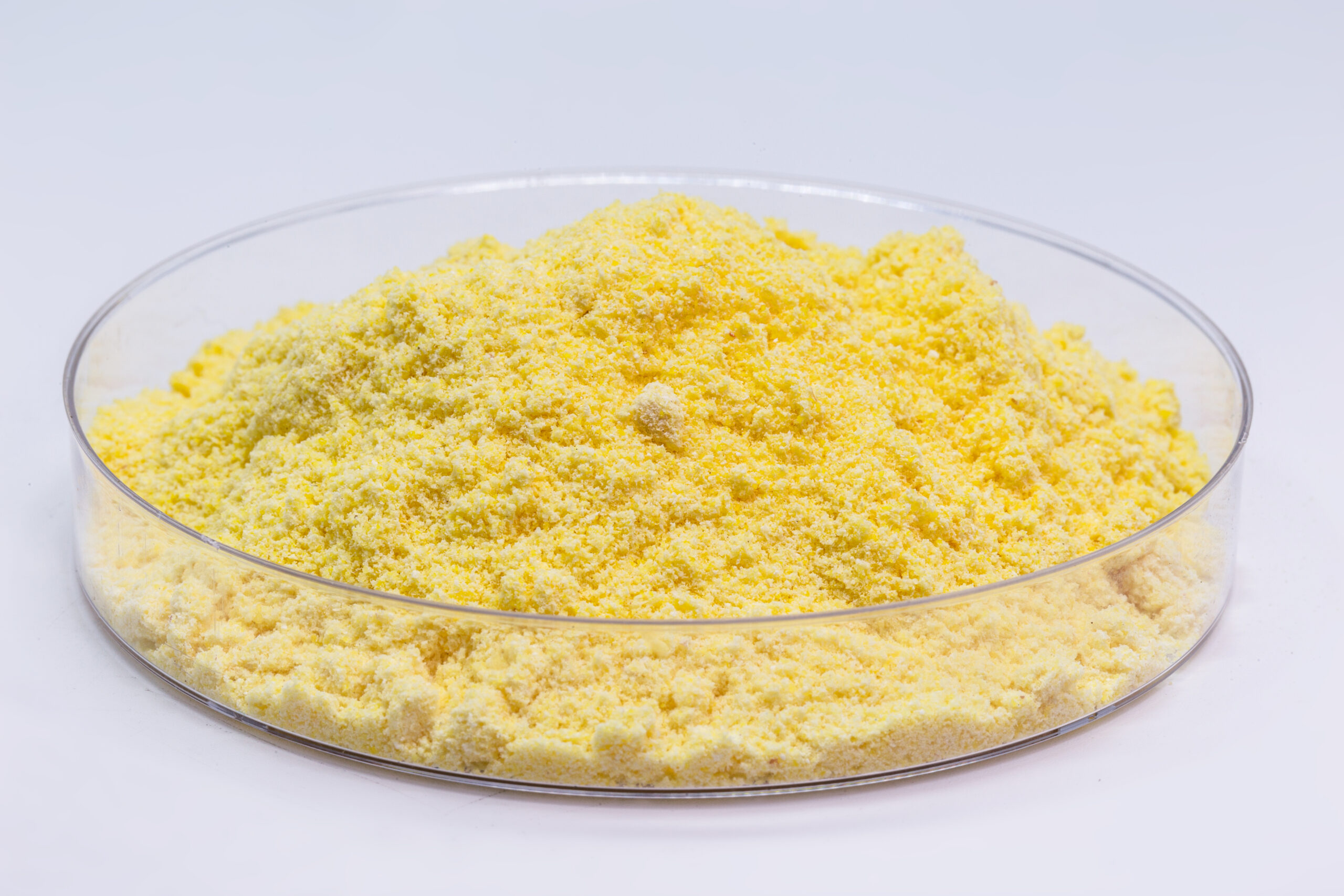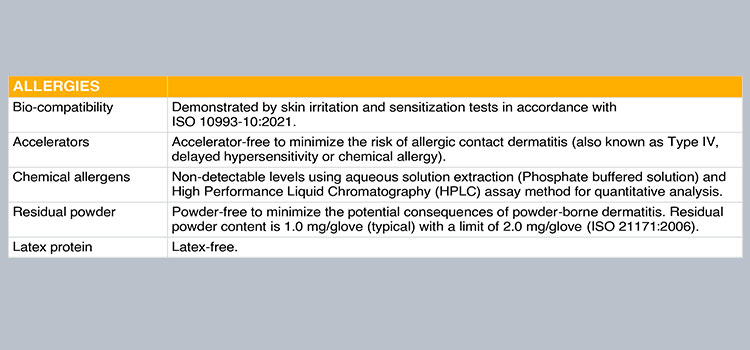ALLERGIC CONTACT DERMATITIS (TYPE IV) AND ITS IMPLICATIONS FOR SINGLE-USE GLOVES

In many professional settings, protecting your hands from chemical or biological hazards by wearing single-use gloves is very common. These gloves are then considered Personal Protective Equipment (PPE) and complement existing organizational protection measures. Unfortunately, single-use gloves that are worn for their protective properties can sometimes cause potentially very serious allergic reactions such as an allergy to Natural Rubber Latex (Type I) or dermatoses which may cause skin inflammation.
Apart from Natural Rubber allergy, which is specific to natural rubber latex gloves, there are two types of dermatitis that are generally associated with single-use gloves:
- Irritant contact dermatitis: it is skin irritation. Prolonged wearing of single-use gloves can lead to heavy sweating. The resulting humid environment can cause irritation. Powder that is sometimes added to gloves can also be an irritant.
- Allergic contact dermatitis, also known as delayed hypersensitivity reaction or Type IV allergy: This allergic reaction occurs (within a few hours or days) after exposure of a person that is already sensitized (during a previous exposure) to one or more of the allergens contained in the glove material. It is important to note that it can occur regardless of the nature of the main material of the glove: natural rubber latex or synthetic rubber such as nitrile or neoprene.
It is therefore important to understand the causes of allergic contact dermatitis (Type IV) and its association with the wearing of single-use gloves. In this way, users can recognize the symptoms and identify the actions to be taken to prevent allergic contact dermatitis.
WHAT IS ALLERGIC CONTACT DERMATITIS (TYPE IV ALLERGY)?
Allergic contact dermatitis occurs after exposure of the skin to an allergen present in the gloves’ components. This is a cell-mediated hypersensitivity reaction (Type IV) that causes an inflammatory reaction against antigens.
Remember an allergic reaction can only occur after a first exposure to an allergen but may go unnoticed because the glove wearer experiences no symptoms.
Allergic contact dermatitis can appear acutely or more chronically (during persistent contact with the source of the allergy).
First symptoms of allergic contact dermatitis are very often redness, swelling, small blisters and itching. When allergic contact dermatitis is long-lasting, then symptoms of dry skin, thickening of the skin, peeling, open lesions, papules may occur etc.
Figure 1 – Examples of dermatitis symptoms
These symptoms usually occur between 6 and 48 hours after contact with the allergen(s) (hence the name delayed hypersensitivity) and can worsen during the following days.
The symptoms of allergic contact dermatitis are similar or nearly identical to those of irritant contact dermatitis. It should therefore be noted that to distinguish them, pay attention to the symptoms that are specifically related to allergic contact dermatitis. In this context, the symptoms of allergic contact dermatitis are not confined to the skin directly in contact with the glove and in time can extend more widely to the arm.
WHAT CAUSES CONTACT ALLERGIC DERMATITIS (TYPE IV)?
There are many causes of allergic contact dermatitis such as: cosmetics, perfumes, some ingredients used in the manufacturing of medicines, metal compounds such as nickel, plants as well as chemical sensitizers such as plasticizers, stabilizers, antioxidants, biocides, agents to facilitate the donning of gloves, pigments, or dyes…
But the most frequently implicated allergens in Type IV allergy related to single-use nitrile or latex gloves are vulcanization accelerators (some 80% of allergic contact dermatitis cases when wearing single-use gloves are related to accelerators).

Vulcanization is a chemical reaction obtained from the addition of agents such as sulphur (or other chemical agents) to the natural or synthetic rubber during disposable gloves manufacturing. This manufacturing stage is to solidify the materials by creating “bridges” between the molecular chains of the gloves’ components giving them their elasticity properties (which allows for a return to a normal state after being stretched).
To speed up the vulcanization process, chemical agents are sometimes added. These agents are called vulcanization accelerators, which alone or in combination can potentially lead to an allergic reaction.
The main potential allergenic vulcanization accelerators used in single-use gloves manufacturing fall into several groups (https://www.ncbi.nlm.nih.gov/pmc/articles/PMC8561832/) :
– Thiurams
– Dithiocarbamates
– Benzothiazoles (or Thiazoles)
– Thioureas
– Guanidines
Any inflammatory skin reaction that occurs when wearing single-use gloves should lead the wearer to investigate the possible cause in order to consider potential treatment options.
HOW TO MANAGE GLOVE-ASSOCIATED ALLERGIC CONTACT DERMATITIS?
If a Type IV allergy is suspected:
- Immediately change glove type and wear gloves known to be low in residual chemicals and low in chemical contact sensitizers.
- Ask the nitrile or natural rubber Latex gloves manufacturer for:
- Test report based on high-performance liquid chromatography (HPLC) demonstrating that it was not possible to detect residues of the most common sensitizing chemicals in the gloves.
- Proof that the gloves have passed the sensitization test.
- Choose non-powdered single-use gloves.
Figure 3 – Extract from Product Data Sheet for SHIELDskin™ ORANGE NITRILE™ 300 gloves
- Wear cotton or nylon inner-gloves, making sure to replace them each time the outer-gloves are changed.
If symptoms persist:
It is essential to consult an occupational doctor or a dermatologist who will carry out a thorough diagnosis possibly including skin tests to determine the allergenic products involved.
If a chemical allergen has been identified during a skin test, all contact with this allergen must be avoided, keeping in mind that the same chemical agent may be found elsewhere such as in fungicides or adhesives for example.
KEY POINTS TO REMEMBER ABOUT ALLERGIC CONTACT DERMATITIS WITH DISPOSABLE GLOVES
Allergic contact dermatitis with single-use gloves is particularly common in occupations where gloves are frequently worn, sometimes for long periods of time.
Allergic contact dermatitis is mainly caused by vulcanizing accelerator chemicals during single-use gloves manufacturing.
If an allergy to a vulcanization accelerator or group of accelerators is proven, then care must be taken to avoid contact with this accelerator or others of the same group. If in doubt, it is recommended to avoid contact with any type of accelerator and to use gloves made without any accelerator.
It is therefore strongly recommended to ensure that the disposable latex or nitrile gloves used are marked “accelerator-free”. Statements such as “recommended for people with allergies” or “hypoallergenic” deserve special attention because they can be misleading and may only relate to the absence of natural latex rubber in the gloves. Again, if in doubt, the single-use gloves manufacturer should be asked to provide information about the accelerators used in their gloves manufacturing process.
To make an informed choice about selecting the appropriate disposable gloves, it is essential to know about the manufacturing conditions and how this contributes to the quality of the gloves.
To help you select SHIELD Scientific single-use gloves that reduce the risk of allergic reactions while providing the desired protective properties, we invite you to consult the technical sheet of each SHIELD Scientific nitrile or natural rubber Latex glove. You can also use our glove selection guide.
Do not hesitate to contact us for any further requests.
Share this interesting information


